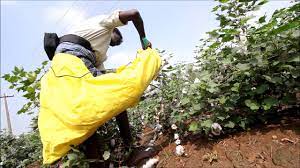The Cotton Corporation of India (CCI) has so far distributed 5543 Kapas Plucker machines valuing around Rs. 4 crores to 5543 marginal & small farmers in all the cotton-growing states (including aspirational districts) under Corporate Social Responsibility (CSR).
As CCI is a Nodal agency of Govt. of India under Ministry of Textiles for undertaking Minimum Support Price (MSP) operations of cotton in the event market rate of seed cotton falls below the MSP rates to protect the cotton farmers from distress sale. Therefore, the CSR budget of the Corporation remains very limited.
Despite this constraint, the Corporation distributed Kapas Plucker machines to marginal and small farmers in all the cotton-growing states. Most of the cotton in India is manually picked which is a labor-intensive operation.
Unlike other major cotton-producing Countries like the USA, Australia, etc, fully mechanized harvesting by big machines are not successful in India due to the small landholdings of cotton farmers in India, sowing/picking pattern (3-4 picking) and different climatic condition in different States.
Therefore, the handheld Kapas Plucker machine is one of the options to bring down the cost for the farmers and a remedy for contamination at the farm level due to manual picking. The Handheld Kapas Plucker machine is a lightweight (about 600 gram) machine that has a pair of rollers inside having small edged teeth on their outer periphery and is operated by a lightweight 12 volt.
Cotton gets entangled with the rollers and is collected directly into a collection bag attached to it. The design of the machine makes it easy to operate in the field and affordable i.e. at a nominal cost of Rs. 8000 per machine (approx.).
Advantages of Kapas Plucker Machines
- Reducing the risks of health hazards to cotton farmers in manual picking (i.e. risk of insect bite, back pains due to standing posture for long hours, bruises/cutting on legs & hands, etc).
- Improve the cotton harvesting skills, reduce the dependency on scarce & costly labor and make cotton farmers “Aatmanirbhar”
- Improve the quality of cotton by reducing contamination at the farm level.
- Financial returns to cotton Farmers may improve by reducing harvest cost (reduced labor requirement), lesser trash & contamination, and premium on the sale of better quality cotton.
- Due to the availability of indigenous good quality cotton, the quality of cotton yarn, textiles, and value-added products will also increase which may increase foreign exchange earnings.
This news has not been edited by Apni Kheti staff but has been published by various news feeds
Source: Krishi Jagran

